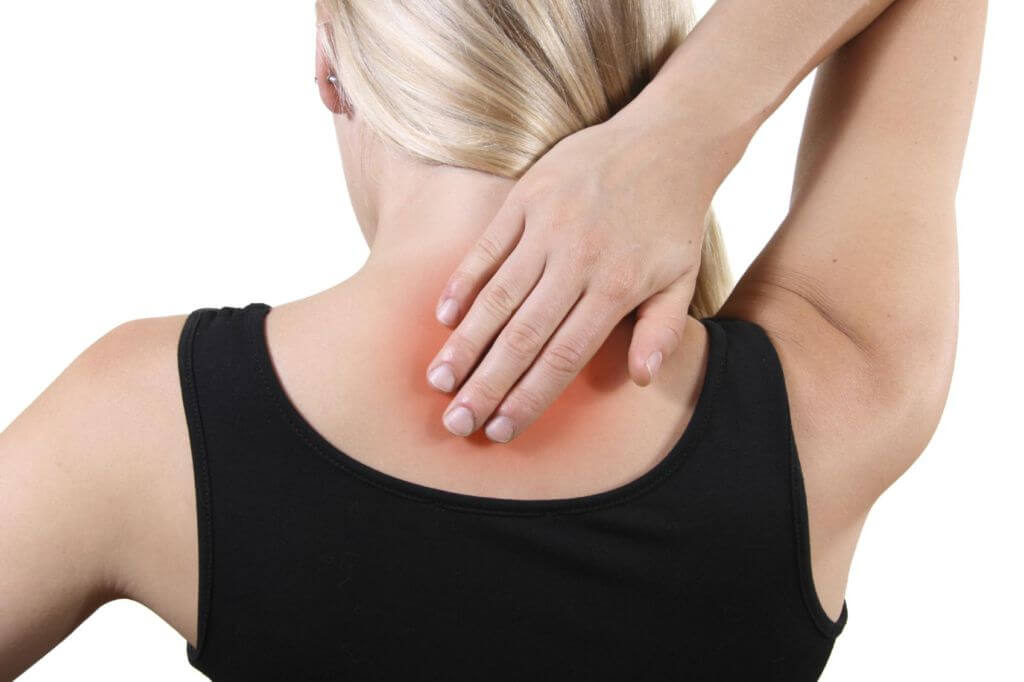Table of Contents
- What Causes Back Pain in Females?
- Upper Back Pain Causes
- Risk Factors for Back Pain
- Back Pain Conditions Among Women
- Organs That Cause Back Pain
- How Can Hormonal Changes Cause Back Pain?
- When Pain Does Not Go Away
Back pain is a symptom of a variety of medical conditions, illnesses and injuries. Men, women and children have acute or chronic back pain, but there are some conditions that women are more prone to experience than men. For example, more women than men deal with chronic lower back pain. Following are some of the common causes of back pain in women.
What Causes Back Pain in Females?
Back pain is due to any of a number of conditions. Sometimes the pain is due to a problem in the spine or supporting muscles, ligaments and tendons. However, back pain can also be due a problem in another part of the body, and people experience what is called referred pain.
Pain can occur in any area of the back too. It may be localized pain, like lower back pain or neck pain, or it may be widespread back pain. The general categories of causes for back pain in females include:
- Back sprain or strain,
- Spinal injury to vertebrae or spinal nerves,
- Diseases like osteoporosis and disc disease,
- Arthritis,
- Medical condition like a bladder or kidney infection,
- Hormone fluctuations.
Girls with lower back problems are usually experiencing pain from a sports injury or an accident. In these cases, lower back pain is due to a pulled muscle or strained ligament. Carrying heavy backpacks is another cause of back pain in young people. Girls reaching puberty and menstruating may also experience back pain due to hormone changes. Being overweight or obese is yet another cause of back pain in children.
What Causes Upper Back Pain?
The upper back or thoracic spine is the area that starts at the base of the neck and extends to the bottom of the ribcage. Upper back pain in women is usually due to:
- Poor posture, like slouching or pushing the head forward while sitting or standing, causing misalignment of the spine
- Muscle overuse or strain, usually due to repetitive motions or lifting items or children incorrectly
- Injury to discs, muscles and/or ligaments
- Myofascial pain
- Arthritis
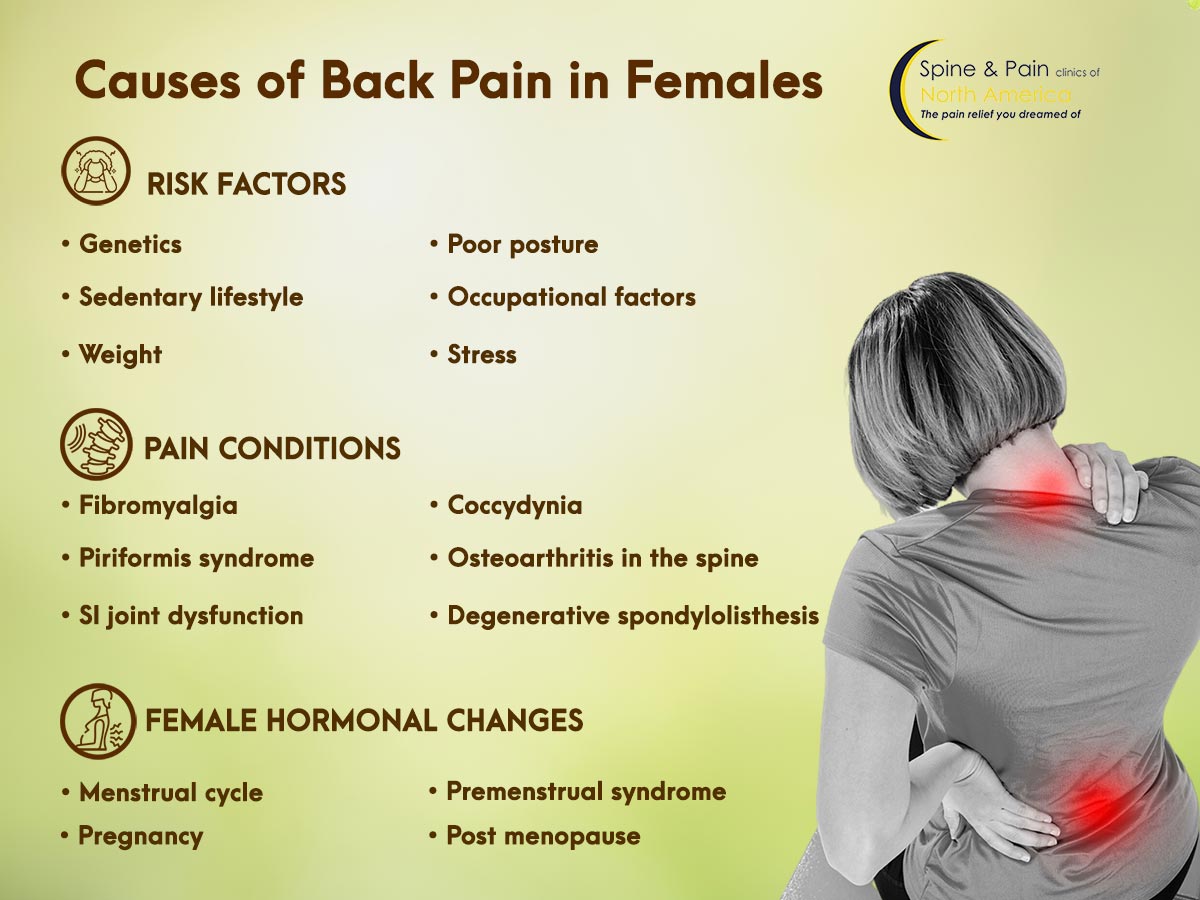
Many instances of back pain are not serious. Minor strains and sprains will usually heal on their own. In a number of cases, correcting posture or getting more exercise to strengthen back tissues can prevent further instances of back pain.
Risk Factors for Low and Upper Back Pain
1. Genetics
Some people are genetically predisposed to certain spinal conditions, such as degenerative disc disease or spinal stenosis. These conditions may cause lower back pain.
2. Sedentary Lifestyle
A sedentary lifestyle and low levels of physical activity have been associated with a higher risk of developing lower back pain. Lack of exercise weakens the muscles in the back, buttocks, abdomen and thighs that support the spine. Prolonged sitting decreases the spinal disks’ water supply, leading to disk herniations, disk degeneration and reduced muscle strength.
Sedentary Work Day?
Here are everyday hacks on how to increase your daily movement
3. Weight
Chronic low back pain has been linked to being overweight or obese. Obesity is associated with cartilage inflammation, disk degeneration and overloading of joints, impacting the lumbar discs and joints.
4. Poor Posture
When standing, sitting and walking, poor posture can cause misalignment of the spine, which leads to low back pain. Pressure on the spine is not evenly distributed across joint surfaces.

Read the post “How to Straighten Your Back and Correct Spine Posture“
5. Occupational Factors
Lifting is a risk factor for low back pain when improper lifting techniques are used. Other movements that may lead to lower back pain include repetitive movements or regularly twisting, pulling or pushing something heavy without adequate breaks.
6. Degree of stress
Studies have found a significant association between a person’s stress level and lower back pain. Psychosocial factors also include anxiety and depression.
Back Pain Conditions That Mainly Affect Women
The general categories mentioned include a variety of acute and chronic pain conditions that are more commonly experienced by women. Some causes can happen at any age, while others are frequently seen in older people. In fact, old lady back pain refers to pain experienced due to the aging process that leads to joint degeneration in the spine.
Following are some specific conditions that females commonly experience that cause back pain.
1. Fibromyalgia
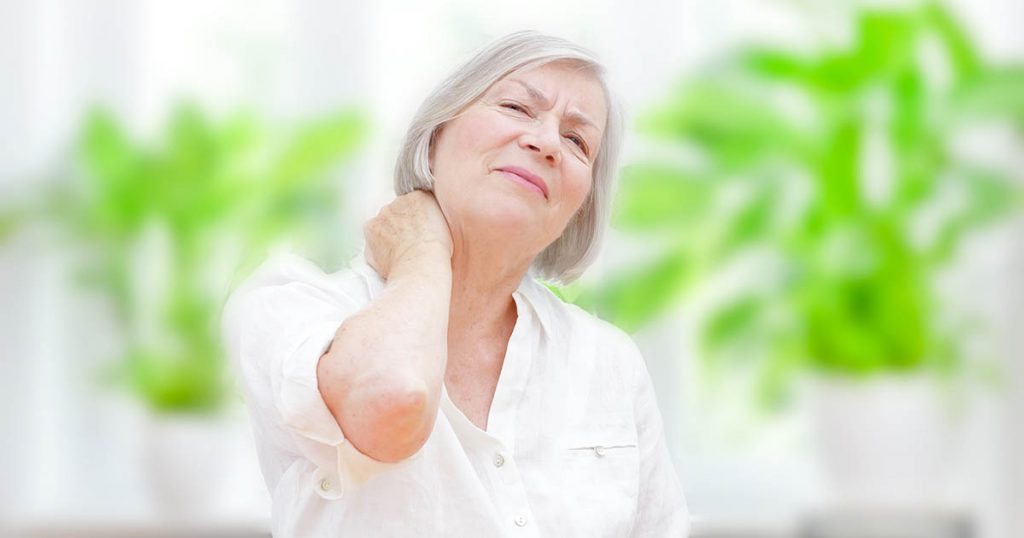
Fibromyalgia – a condition with muscle pain and stiffness that can cause widespread back pain. It is characterized by widespread musculoskeletal pain along with stiffness, fatigue, sleep disturbance, cognitive difficulties and mood changes such as anxiety or depression.
Currently, the exact etiology of fibromyalgia is not enough studied. Patients suffering from fibromyalgia may have a lower threshold for pain due to increased pain-sensitivity signals in the brain. Women are more likely to develop fibromyalgia than men because it is considered that female hormones play a role in a feeling of pain.
2. Piriformis Syndrome
The piriformis muscle is connected to the lower spine, goes through the buttock and connects to a bone at the top of the thigh. There is a piriformis muscle on each side of the body, and it plays a big role in assisting with the lower body’s movement. The large sciatic nerve is located under the piriformis muscle. It runs from the spinal cord and down each leg.
Piriformis syndrome exists when the narrow, flat piriformis muscle presses on and irritates the sciatic nerve and causes painful inflammation. It is not common, but it can be as painful as sciatica. Piriformis syndrome affects more women than men, but the specific reason for this is not known.
3. Sacroiliac Joint (SI Joint) Dysfunction
The sacroiliac joint (or SI Joint) covers the sacrum with the pelvis and is adjacent to the bottom of the spine. The treatment goal is to restore the normal SI joint’s range of motion. The sacroiliac joint dysfunction can lead to low back pain and it is generally more common in young and middle-aged women.
SI joint serves as a cushion between the upper body and pelvis, and dysfunction could be caused by pregnancy, walking pattern, osteoarthritis, injury, etc.
4. Coccydynia
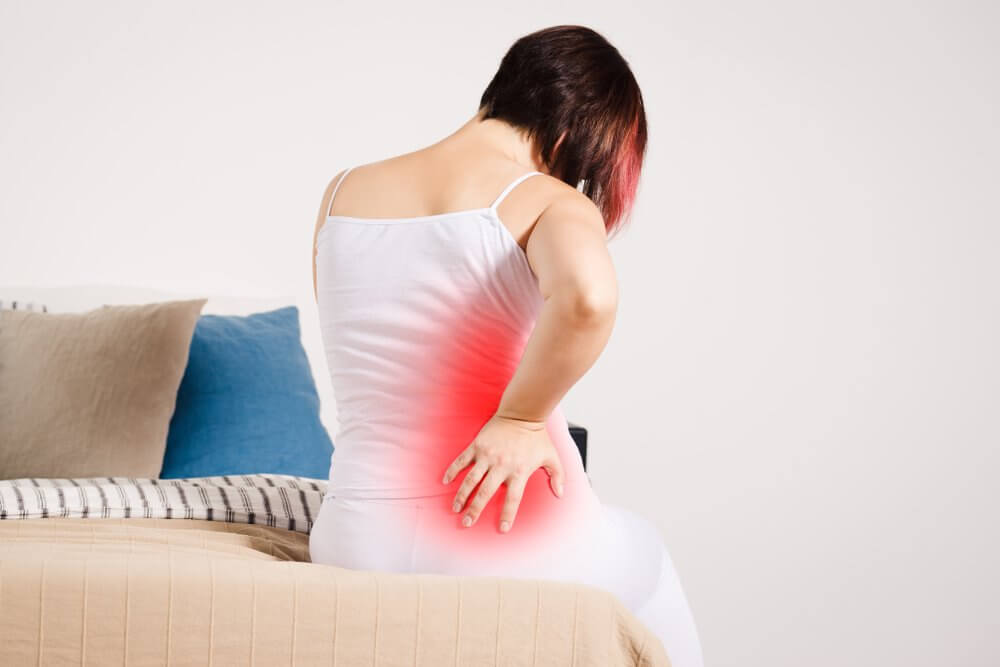
Coccygodynia is tailbone pain. The tailbone is the last segment of the vertebral spine and bears weight. Coccydynia is another condition that affects women more than men. The National Institutes of Health (NIH) says women are five times more likely to develop this condition than men. For women, tailbone pain can develop due to:
- Joint degeneration
- Injuring the coccyx during a fall or other incident causing bone trauma
- Sitting for a long period of time on a hard surface
5. Osteoarthritis in the Spine
Osteoarthritis is a degenerative joint disease that leads to a breakdown of the cartilage in facet joints; can lead to a compression fracture anywhere in the spine due to thinning bones.
6. Degenerative Spondylolisthesis
Degenerative spondylolisthesis causes a back pain when a lower back vertebrae slips forward over the one beneath it, irritating spinal nerve roots.
7. Medical Disorders
There are more disorders that cause referred back pain in women, i.e. kidney or bladder infections, ovarian disorders, uterine fibroids, pelvic infections, etc.
Of cousre, there are other causes affecting women, but men are just as likely to develop many of them. For example, a woman or a man can injure her back playing sports or lifting heavy weights in the gym or at work. Men and women develop cancer or experience herniated discs.
Organs That Cause Lower Back Pain in Women
Various organs can cause lower back pain in women.
1. Dysmenorrhea
A uterine dysfunction, the woman experiences severe cramping when menstruating. Primary dysmenorrhea begins with the first menstrual cycle and continues throughout her lifetime. Secondary dysmenorrhea is severe cramping that starts later in life and is the result of a condition like pelvic inflammatory disease.
2. Kidney Infection
Acute pyelonephritis (APN) is the medical name for a kidney infection. It is a severe infection of the urinary tract and can be quite painful. The infection may begin in the bladder and urinary tract and then spread to the kidneys. The infection can occur in one kidney, leading to intense pain in the lower back on the side of the infected kidney.

3. Inflammatory Bowel Disease (IBD)
IBD includes ulcerative colitis and Crohn’s disease. It sometimes leads to the development of ankylosing spondylitis (spondylarthritis), a type of arthritis that causes spine inflammation. IBD can lead to chronic lower back pain.
4. Pancreatitis
The pancreas aids with food digestion through enzyme production and also assists with controlling blood sugar levels through the release of hormones. When the pancreas becomes inflamed, it can cause upper abdominal pain that may spread to the lower back.
5. Appendicitis
The appendix is a small pouch-like organ that extends from the colon on the right side of the lower abdomen. Appendicitis is when the organ becomes inflamed or infected. One of the symptoms is lower right back pain.
6. Liver Disorders
There are several liver disorders than impede the organ’s functioning. They include hepatitis and cancer. When the liver swells, it presses on the lower back’s nerves and causes low back pain.
How Can Female Problems and Hormonal Changes Cause Lower Back Pain?
Female sex hormones play an important role in a variety of degenerative diseases of the muscles and bones and in pain sensitivity. Following are some of the common causes of hormonal back pain.
1. Menstrual Cycle
Hormone fluctuations increase pain sensitivity and affect the muscles. Women experience referred pain from the lower abdomen to the lower back during their menstrual cycle.
2. Pregnancy
During pregnancy, the body releases a hormone called relaxin that relaxes joints and ligaments in the pelvic area to allow the fetus to grow. The hormone changes can cause supporting ligaments in the spine to loosen too, causing sacroiliac joint dysfunction.
Hormonal changes and pressure placed on the lower back area by a growing baby, including the tailbone, are top causes of lower back pain in women.
An increasing weight of the baby in the uterus leads to changes in posture that stress back, hip and leg joints.
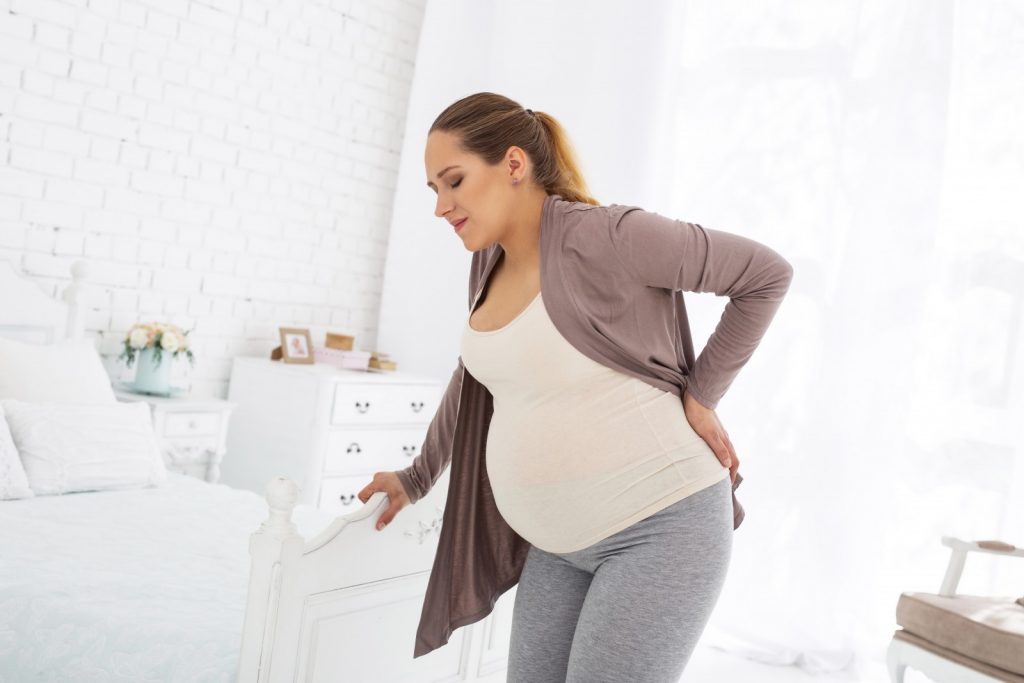
3. Endometriosis
Endometriosis is a condition in which cells that are similar to uterus lining cells grow outside the uterus. The cells, acting like endometrial tissue, may grow on the ovarian or fallopian tubes or in other areas of the pelvic cavity. During the menstrual cycle, the cells will swell and cause bleeding which leads to lower back pain and other painful symptoms.
4. PMS (Premenstrual Syndrome)
Premenstrual syndrome is a combination of symptoms that women experience several days to a week before the start of menstruation. The symptoms often include low back pain which is believed to be caused by changes in hormones. The hormone prostaglandin is released during the menstrual cycle to prepare the uterus to shed the uterine lining.
5. Post Menopause
Spinal disc degeneration accelerates due to declining estrogen levels post-menopause.
6. Pelvic inflammatory disease
Pelvic inflammatory disease is an inflammation of the upper genital tract in women. It is caused by a bacterial infection that spreads from the lower to upper genital tract. The pelvic area is close to the lower spine, so the pain from inflammation may radiate to the lower back. The condition needs prompt treatment to avoid complications from developing.
7. Fibroids
Fibroids are non-cancerous tumors that develop and grow in the muscular wall of the uterus. The fibroids that grow on the uterus’s back side can exert pressure on the muscles and nerves in the lower spine. The nerves are pinched, leading to localized or radiating pain in the pelvis. The fibroid usually must be quite large before it causes low back pain.
8. Ovarian cysts
Ovarian cysts are fluid-filled sacs that develop in or on the ovaries. They can grow large enough to pressure surrounding abdominal tissues and organs. The pressure on the nerves and tissues can radiate pain to the lower back and legs. Like fibroids, the cyst must usually grow significantly to cause noticeable back pain.
9. Adenomyosis
Adenomyosis is a benign condition, in which the lining of the uterus grows into the uterus’s muscular walls. One of the lesser-known symptoms of this condition is lower back pain. The uterus enlarging to three times its normal size can lead to referred pain, which can cause pain in the back and legs. The pressure on nerves or organs can also cause pain.
Relief for Lower Back Pain
Female problems and hormonal changes need a doctor’s attention. However, while the medical issues are being treated, there are ways to relieve lower back pain. They include the following.
1. Hot and cold therapy
Applying an ice or heat pack to the lower back to reduce inflammation and relax muscles.
2. OTC medications
Taking an over-the-counter pain reliever, like an NSAID or acetaminophen or applying a topical patch.
3. Paying attention to posture
Adhering to good standing, sitting and sleeping posture to relieve pressure on nerves.
4. Reducing stress
Practicing relaxation techniques to relieve stress can ease tight muscles and promote other health benefits, such as improved blood flow and mental wellness.
5. Stretching
Doing gentle stretching exercises to relax the muscles.
Since lower back pain in these situations is a symptom of a female problem or hormonal change, the steps to relieve lower back pain are supplemented by medical treatments.
When Pain Does Not Go Away
Chronic back pain is challenging because it makes even the simplest tasks or movements difficult. For women, it is low back pain that often drives them to see a physician for evaluation.
Persistent pain should not be ignored because it may be due to something more serious than a sprain or strain, like sciatica, a ruptured disc, or an infection. Sharp pain that comes on suddenly should not be ignored either. It is always better to see a physician when home remedies do not help relieve pain, or acute or chronic pain interferes with life activities.
Specialists at the Spine and Pain Clinics of North America can help you understand the causes of your pain and develop an effective treatment plan. Don’t hesitate to reach out for professional assistance and take the first step towards a pain-free life.
![]()
Call (703) 520-1031 or use the form below to ask any questions concerning physical therapy and arthritis treatment.
Sources
- https://www.nature.com/articles/s41413-023-00280-x
- https://www.ncbi.nlm.nih.gov/pmc/articles/PMC7354496/
- https://www.aafp.org/pubs/afp/issues/2022/0300/p239.html
- https://www.ncbi.nlm.nih.gov/pmc/articles/PMC5931150/
- https://www.ncbi.nlm.nih.gov/pmc/articles/PMC8767074/
- https://www.mdpi.com/1660-4601/14/2/183
- https://www.ncbi.nlm.nih.gov/pmc/articles/PMC10548303/
- https://www.ncbi.nlm.nih.gov/pmc/articles/PMC8282867/
- https://www.ncbi.nlm.nih.gov/books/NBK499959/
- https://www.ncbi.nlm.nih.gov/pmc/articles/PMC10876847/
- https://www.ncbi.nlm.nih.gov/books/NBK279535/
- https://www.ncbi.nlm.nih.gov/pmc/articles/PMC4503903/
- https://atlii.com/adenomyosis-symptoms/back-pain/
